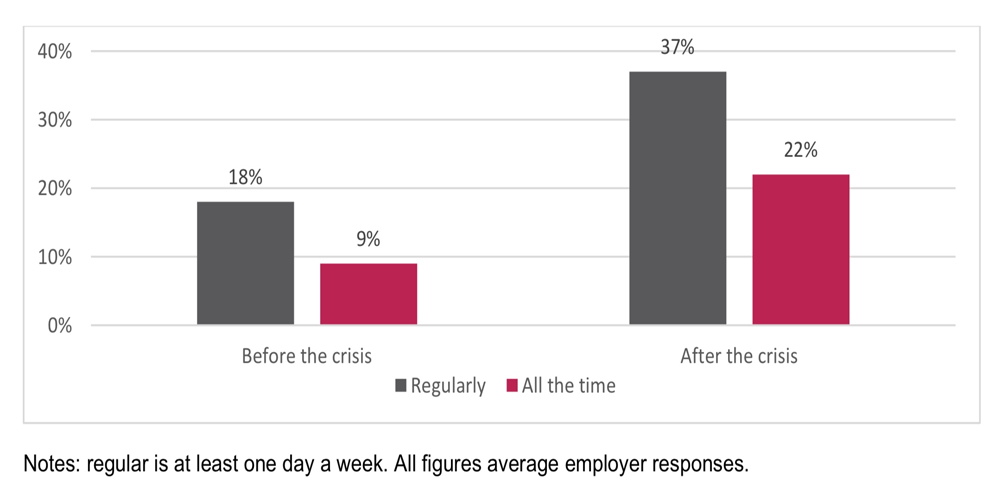CIPD’s latest report has highlighted the need for employers to prioritise flexibility and staff mental health support as home working expands and becomes a more permanent arrangement. Although the shift to home working during the pandemic has been a positive experience for most employers, it’s not been without its challenges. Around two thirds of employers report staff to be just as productive, if not more than they were in the workplace pre-pandemic, reveals the UK’s professional body for HR and people development.
However, CIPD’s Embedding New Ways of Working research, of more than 1,000 employers, highlights several challenges associated with managing home workers. For example, many are struggling with reduced staff mental wellbeing (47%). Some of the other challenges include problems with staff interaction/co-operation (36%), difficulties with line managing home workers (33%) and monitoring their performance (28%). The report also reveals the risks of a two-tier workforce, as the gap between home workers and other employees who have to go to work and have little flexibility is expected to grow.
HOMEWORKING BENEFITS
Nonetheless, CIPD’s research shows that the benefits of home working significantly outweigh the challenges. Overall, the shift to home working amid the pandemic has been a positive experience for most employers. Benefits include improved work-life balance (cited by 61% of employers), enhanced employee collaboration (43%), improved focus (38%) and IT upskilling (33%). Approximately 28% of employers also reported that the increase in home working has boosted productivity, while 37% say it has not impacted productivity levels, and around 28% of employers reporting a decrease.
Given the benefits, many employers are planning to expand home working, and make the arrangement more permanent once the crisis is over. Many expect the proportion of staff working from home regularly to double (to 37%) after the crisis is over, compared to pre-pandemic (around 18%). Organisations also predict the proportion of the workforce that works from home all the time to more than double to 22%, compared to 9% before the crisis.

SUPPORT MEASURES NEEDED
In addition, 44% of organisations are planning to put in place additional measures or investment to support home working. Of these, two thirds of employers (66%) plan to change organisational policy to promote more homeworking. A majority of employers also said they were going to increase investment in technology in terms of improving the quality of technology (59%) and the quantity of laptops and computers (51%).
However, employers are much less likely to be planning to introduce or increase other forms of flexible working (such as annualised hours, term-time working, compressed hours or job sharing), which can be used by workers who are unable to work from home. Overall, just a third (33%) of employers say they plan to introduce new forms of flexible working or increase the uptake of existing flexible working arrangements more broadly, once lockdown restrictions ended. Where changes are planned, working from home regularly (70%) or all the time (45%) are most commonly cited, followed by part-time working (40%), flexi-time (39%) and compressed hours (25%).
CATALYST FOR CHANGE
Commenting on the findings, CIPD’s CEO Peter Cheese, stated: “The step-change shift to home working to adapt to lockdowns has taught us all a lot about how we can be flexible in ways of working in the future. This should be a catalyst to change long held paradigms and beliefs about work for the benefit of many. Employers have learnt that, if supported and managed properly, home working can be as productive and innovative as office working and we can give more opportunity for people to benefit from better work-life balance. This can also help with inclusion and how we can create positive work opportunities across our economies.”

However, Cheese points out that home working “doesn’t suit everyone”. Increasingly organisations will have to design working arrangements around people’s choice and personal preference over where and when they would like to work, whilst also meeting the needs of the business.
FLEXIBLE ARRANGEMENTS
“Employers will also have to redouble efforts to introduce flexible working arrangements for staff unable to work from home otherwise they will increasingly have a two-tier workforce of those who have opportunity to benefit from home working and flexibility and those who don’t,” he added. “It is often essential workers and lower paid front line staff who are not able to work from home and it is crucial these workers are not left behind when we think about flexible working. Making the right to request flexible working a day one right would support the uptake of a wider range of flexible working beyond home working.”
Click here for CIPD’s Embedding New Ways of Working report. A recent US report also reiterates CIPD’s findings and urges employers globally to provide staff with more mental help support amid the pandemic.







































